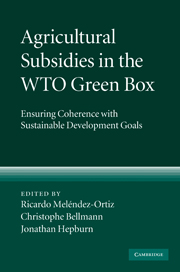Book contents
- Frontmatter
- Contents
- List of contributors
- Preface
- Acknowledgements
- List of abbreviations
- 1 Overview
- PART I The recent evolution of agricultural trade policy reform
- PART II The focus, extent and economic impact of green box subsidies
- PART III Green box subsidies and developing countries
- PART IV Green box subsidies and the environment
- PART V Looking forward: how can change take place?
- 19 Improving monitoring and surveillance of green box subsidies
- 20 EU subsidy reform: options for achieving change
- 21 Subsidy reform in the US context: deviating from decoupling
- 22 Agricultural trade policy reform in Japan: options for achieving change
- 23 Towards a green box subsidy regime that promotes sustainable development: strategies for achieving change
- Appendix: Text of Annex 2 of the WTO Agreement on Agriculture (“the green box”)
- Index
- References
22 - Agricultural trade policy reform in Japan: options for achieving change
from PART V - Looking forward: how can change take place?
Published online by Cambridge University Press: 03 May 2010
- Frontmatter
- Contents
- List of contributors
- Preface
- Acknowledgements
- List of abbreviations
- 1 Overview
- PART I The recent evolution of agricultural trade policy reform
- PART II The focus, extent and economic impact of green box subsidies
- PART III Green box subsidies and developing countries
- PART IV Green box subsidies and the environment
- PART V Looking forward: how can change take place?
- 19 Improving monitoring and surveillance of green box subsidies
- 20 EU subsidy reform: options for achieving change
- 21 Subsidy reform in the US context: deviating from decoupling
- 22 Agricultural trade policy reform in Japan: options for achieving change
- 23 Towards a green box subsidy regime that promotes sustainable development: strategies for achieving change
- Appendix: Text of Annex 2 of the WTO Agreement on Agriculture (“the green box”)
- Index
- References
Summary
Introduction
Although Japanese agriculture has long been protected from overseas competition by border measures, the state of the country's farming has continued to decline. Japan has established an agricultural policy dominated by price support that supports farmers' income, but places a large burden on consumers. In order to maintain high prices, Japan has to rely on tariffs. High prices have slowed down structural reform and deprived Japanese agriculture of international competitiveness. In moves to strengthen international competitiveness, the European Union (EU) has lowered prices for agricultural products and introduced a direct payment scheme. Japan should transform its agricultural policy to cease price supports backed by tariffs on products such as rice and use direct payments to compensate farming households that are affected by reduced prices. This would not only overcome immediate obstacles to trade negotiations, but also reduce the burden on the Japanese public, lead to greater competitiveness in agriculture, cope with a shrinking domestic market and offer benefits to consumers. For structural reform, it will be necessary to reduce prices and adopt direct payments limited to eligible farms. In order to adopt aggressive agriculture policy, there is a vital need to carry out structural reform and achieve strong and robust farming.
There are political obstacles which hinder the Japanese Government from realizing this policy reform. In particular, most of the politicians in the Diet believe that in the latest election of the upper house, rural voters showed a negative attitude towards targeting agricultural policies only at eligible farmers.
- Type
- Chapter
- Information
- Agricultural Subsidies in the WTO Green BoxEnsuring Coherence with Sustainable Development Goals, pp. 618 - 632Publisher: Cambridge University PressPrint publication year: 2009



